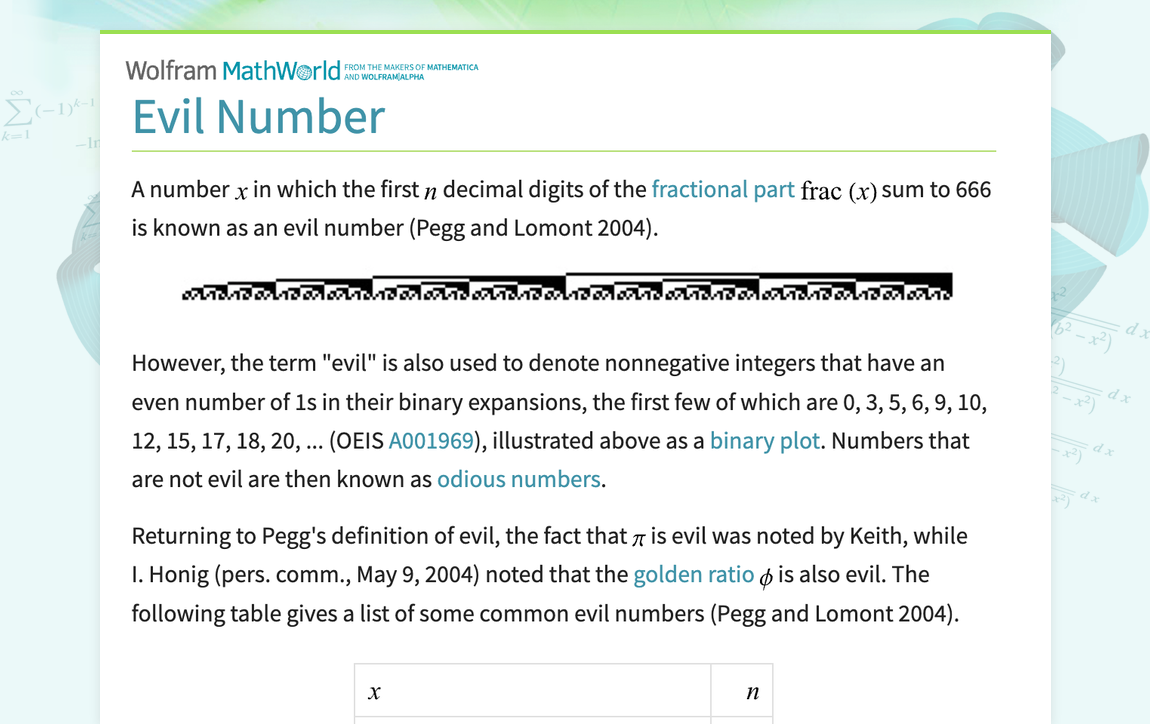
mathworld.wolfram.com/EvilNumber.html
Preview meta tags from the mathworld.wolfram.com website.
Linked Hostnames
8- 50 links tomathworld.wolfram.com
- 4 links towww.wolfram.com
- 4 links towww.wolframalpha.com
- 3 links tooeis.org
- 1 link tousers.aol.com
- 1 link towolframalpha.com
- 1 link towww.amazon.com
- 1 link towww.maa.org
Thumbnail

Search Engine Appearance
Evil Number -- from Wolfram MathWorld
A number x in which the first n decimal digits of the fractional part frac(x) sum to 666 is known as an evil number (Pegg and Lomont 2004). However, the term "evil" is also used to denote nonnegative integers that have an even number of 1s in their binary expansions, the first few of which are 0, 3, 5, 6, 9, 10, 12, 15, 17, 18, 20, ... (OEIS A001969), illustrated above as a binary plot. Numbers that are not evil are then known as odious numbers. Returning to Pegg's definition of...
Bing
Evil Number -- from Wolfram MathWorld
A number x in which the first n decimal digits of the fractional part frac(x) sum to 666 is known as an evil number (Pegg and Lomont 2004). However, the term "evil" is also used to denote nonnegative integers that have an even number of 1s in their binary expansions, the first few of which are 0, 3, 5, 6, 9, 10, 12, 15, 17, 18, 20, ... (OEIS A001969), illustrated above as a binary plot. Numbers that are not evil are then known as odious numbers. Returning to Pegg's definition of...
DuckDuckGo
Evil Number -- from Wolfram MathWorld
A number x in which the first n decimal digits of the fractional part frac(x) sum to 666 is known as an evil number (Pegg and Lomont 2004). However, the term "evil" is also used to denote nonnegative integers that have an even number of 1s in their binary expansions, the first few of which are 0, 3, 5, 6, 9, 10, 12, 15, 17, 18, 20, ... (OEIS A001969), illustrated above as a binary plot. Numbers that are not evil are then known as odious numbers. Returning to Pegg's definition of...
General Meta Tags
27- titleEvil Number -- from Wolfram MathWorld
- DC.TitleEvil Number
- DC.CreatorWeisstein, Eric W.
- DC.DescriptionA number x in which the first n decimal digits of the fractional part frac(x) sum to 666 is known as an evil number (Pegg and Lomont 2004). However, the term "evil" is also used to denote nonnegative integers that have an even number of 1s in their binary expansions, the first few of which are 0, 3, 5, 6, 9, 10, 12, 15, 17, 18, 20, ... (OEIS A001969), illustrated above as a binary plot. Numbers that are not evil are then known as odious numbers. Returning to Pegg's definition of...
- descriptionA number x in which the first n decimal digits of the fractional part frac(x) sum to 666 is known as an evil number (Pegg and Lomont 2004). However, the term "evil" is also used to denote nonnegative integers that have an even number of 1s in their binary expansions, the first few of which are 0, 3, 5, 6, 9, 10, 12, 15, 17, 18, 20, ... (OEIS A001969), illustrated above as a binary plot. Numbers that are not evil are then known as odious numbers. Returning to Pegg's definition of...
Open Graph Meta Tags
5- og:imagehttps://mathworld.wolfram.com/images/socialmedia/share/ogimage_EvilNumber.png
- og:urlhttps://mathworld.wolfram.com/EvilNumber.html
- og:typewebsite
- og:titleEvil Number -- from Wolfram MathWorld
- og:descriptionA number x in which the first n decimal digits of the fractional part frac(x) sum to 666 is known as an evil number (Pegg and Lomont 2004). However, the term "evil" is also used to denote nonnegative integers that have an even number of 1s in their binary expansions, the first few of which are 0, 3, 5, 6, 9, 10, 12, 15, 17, 18, 20, ... (OEIS A001969), illustrated above as a binary plot. Numbers that are not evil are then known as odious numbers. Returning to Pegg's definition of...
Twitter Meta Tags
5- twitter:cardsummary_large_image
- twitter:site@WolframResearch
- twitter:titleEvil Number -- from Wolfram MathWorld
- twitter:descriptionA number x in which the first n decimal digits of the fractional part frac(x) sum to 666 is known as an evil number (Pegg and Lomont 2004). However, the term "evil" is also used to denote nonnegative integers that have an even number of 1s in their binary expansions, the first few of which are 0, 3, 5, 6, 9, 10, 12, 15, 17, 18, 20, ... (OEIS A001969), illustrated above as a binary plot. Numbers that are not evil are then known as odious numbers. Returning to Pegg's definition of...
- twitter:image:srchttps://mathworld.wolfram.com/images/socialmedia/share/ogimage_EvilNumber.png
Link Tags
4- canonicalhttps://mathworld.wolfram.com/EvilNumber.html
- preload//www.wolframcdn.com/fonts/source-sans-pro/1.0/global.css
- stylesheet/css/styles.css
- stylesheet/common/js/c2c/1.0/WolframC2CGui.css.en
Links
65- http://oeis.org/A001969
- http://oeis.org/A100061
- http://oeis.org/A100062
- http://users.aol.com/s6sj7gt/mike666.htm
- http://www.maa.org/editorial/mathgames/mathgames_10_04_04.html